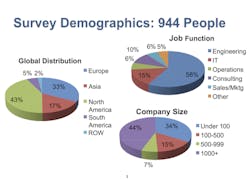Over 900 manufacturing professionals responded to an online survey in late September 2012 providing information about use and intended uses of OPC and OPC UA. Respondents came from Automation World readers and an OPC Foundation (www.opcfoundation.org) mailing list.
Survey questions included:
- Who are you?
- Do you use OPC and OPC UA? How?
- What are most important criteria for product/vendor selection?
- How do you learn about new products/technologies?
Results
What was discovered was that almost three-fourths (72 percent) use "classic" OPC technology. Another 14 percent plan to use it within the next two years for a whopping 86 percent adoption rate.
OPC Unified Architecture (UA) is the latest specification that moves the technology from its Microsoft COM/DCOM roots which are rapidly growing obsolete into the modern world of XML and Web Services. But products supporting this specification have only been available for a few years. Still almost a quarter of the respondents (21 percent) report using OPC UA, while another 36 percent plan to use it within the next two years. That would put adoption at 57 percent. Another 23 percent, though, were not familiar with the new specification. This means there is still some education needed.
The top uses for OPC were:
- Visualization (71 percent)
- Control and integration at DCS/PLC level (59)
- Integrate with production / MES (39)
- Data exchange at controllers (35--big increase from 2005-2012)
- Integrate with ERP (24--doubled from 2005-2012)
- Data exchange at sensor level (20)
Applications for OPC UA were the same, for the most part with two important additions. The first is that 30 percent use OPC UA for data access using Internet technologies. The second is that 8 percent now are embedding OPC UA at the chip/device level.
About the Author
Gary Mintchell
Editor in Chief

Leaders relevant to this article:
